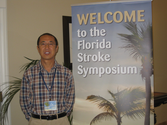|
Stroke Key facts in the United States (1)
What Happens During a Stroke Our brain makes up only 2% of our body weight, but it uses 20% of the oxygen we breathe. If something interrupt the flow of blood, brain cells start to die within minutes because they can’t get oxygen. Sudden bleeding in the brain also can cause a stroke if it damages brain cells. A stroke can cause lasting brain damage, long-term disability, or even death. If brain cells die or are damaged because of a stroke, symptoms of that damage start to show in the parts of the body controlled by those brain cells. Symptoms of Stroke
Types of Stroke
It is Important to Know About TIA
Spinal Stroke Spinal stroke is a rare type of stroke either within the spinal cord or the arteries that supply it. Symptoms, which generally appear within minutes or a few hours of the infarction, may include intermittent sharp or burning back pain, aching pain down through the legs, weakness in the legs, paralysis, loss of deep tendon reflexes, loss of pain and temperature sensation, and incontinence. The causes of spinal stroke are atherosclerosis in 33.3%, aortic pathology in 15.8%, degenerative spine disease in 15.8%, cardiac embolism in 3.5%, systemic hypotension in 1.8%, epidural anesthesia in 1.8%, and cryptogenic in 28%. Research show that after 4.5 years 41% can regain full walking ability, 30% are able to walk with aids, 20% are wheelchair bound, and 9% may die.(2) Quick Treatment Is Critical for Stroke: F.A.S.T.
Stroke Scales NIH Stroke Scale The Barthel Index Acupuncture for Stroke We take care of stroke after ER initial treatment. Any time to have acupuncture treatment is beneficial for stroke, but the early, the better. Acupuncture is effective for the following post stroke conditions:
|
|

